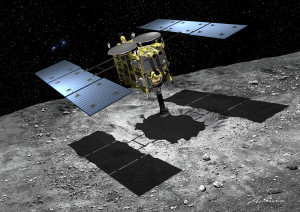
Japan’s Hayabusa2 is pulling up to Ryugu – a C-type asteroid – for detailed study.
Artwork: Akihiro Ikeshita
The Japan Aerospace Exploration Agency’s (JAXA) Hayabusa2 is being readied for its first asteroid Ryugu touchdown and collecting samples next month.
First touchdown
The first Hayabusa2 touchdown (TD1) is planned for the week of February 18. A backup week is March 4.
JAXA Hayabusa2 team members have decided that another target marker will not be dropped onto the asteroid. The target marker (TM-B) previously landed will be used. This marker is to be used in maneuvering the spacecraft to attempt the first sample collection.
Touchdown candidate sites for the asteroid probe that are currently under consideration are identified as L08-B1 and L08-E1. A Digital Elevation Map has been created to accurately estimate the rock shapes near the touchdown candidate sites.
Big shot: carry-on impactor
In addition to touchdown, readiness procedures for a planned deployment of the small carry-on impactor (SCI) were carried out January 16, a test that involved using spacecraft thrusters for about 10 seconds in four directions. This successful test was done in preparation for where the spacecraft must move quickly after separating the SCI.
The SCI is a compact kinetic impactor designed to remove the asteroid surface regolith locally and create an artificial crater for later study by Hayabusa2.
This SCI comprises a roughly 4 pound (2 kilograms) copper lump. This impactor called “Liner” is shot from Hayabusa2 at a velocity of 2 kilometers per second to make an artificial crater by collision conical shape structure filled with explosives.

The names for topographic features on Ryugu’s surface have been decided. The theme is “Names that appear in stories for children”, in keeping with Ryugu. On the map, yellow indicates an official name recognised by the International Astronomical Union while orange is a nickname.
Credit: JAXA
Big boulders
There are scads of boulders distributed on the surface of Ryugu, including a huge boulder near the South Pole. The existence of boulders is important for characterizing the surface layer of Ryugu so JAXA team members decided to name these features.
It has been noted that there was no precedent for the naming of boulders. JAXA suggested Saxum (meaning “rocks and stones” in Latin) as a boulder type and this was adopted by the International Astronomical Union (IAU). At the time of the Hayabusa mission, boulders on the asteroid’s surface were not permitted to be named.

In practice mode, Hayabusa2 image taken at an altitude of about 155 feet (47 meters), captured on
October 15, 2018. Red circle marks a candidate touchdown site, L08-B.
Credit: JAXA, University of Tokyo,
Kochi University, Rikkyo University, Nagoya
University, Chiba Institute of Technology, Meiji
University, Aizu University, (AIST).
Boxing trials
After dealing with a solar conjunction period that ended on December 29, 2018, Hayabusa2 mission controllers continue to sharpen their touchdown skills by moving the probe to various altitudes.
BOX-A corresponds to the Home Position, with an altitude of about 12 miles (20 kilometers).
BOX-B is at same altitude as BOX-A, but the spacecraft can now move plus or minus 6 miles (10 kilometers) forwards, backwards, left and right.
BOX-C has the same dimensions at BOX-A front-to-back and left-to-right, but this region contains an altitude down to about 3 miles (5 kilometers) from the asteroid’s surface.
Another BOX-B operation is slated for this month.




